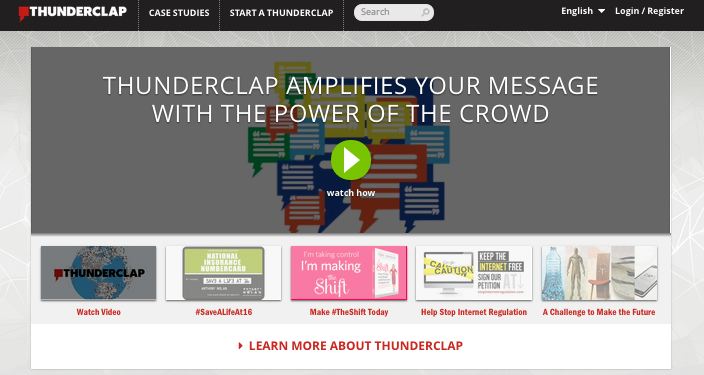Crowd-speaking is one of the newest ways to expand your social media reach. When people support your crowdspeaking campaign, they agree to have a message sent out to their social network (twitter, facebook, etc) at a specific time. This increases the chances that your message, link, or hashtag will go viral.
Thunderclap is the first of these services, launched in May 2012 by De-De, a product development studio. Since it began Thunderclap has been creating some waves, or as Jeff Bercovici put it in a Forbes article:
“The campaign culminates in an explosion of simultaneous tweets big enough to send a ripple across Twitter’s 140 million-strong user base — a ‘disturbance in the Force.'”
This ‘disturbance’ briefly resulted in the service being temporarily shut down by Twitter just after launch, who claimed that Thunderclap was interfering with their own paid business services. Thunderclap decided to experiment with expanding their service to include Facebook, and the Twitter ban was lifted not long after.
Thunderclap has now been getting some competition from HeadTalker, which launched in July 2014. HeadTalker is a new crowd-speaking site powered by crowdfunding platform HeadFunder. It has already seen millions in social reach and could be the first successful alternative to Thunderclap.
As a creator or team behind a crowdfunding project, it can be hard to have your voice heard amidst the high volume of content on social media sites. Crowdspeaking is a useful way to get around that obstacle by asking people’s permission to repost content on your behalf.
When you reach your goal number of supporters, each of these people automatically post your message on their social media pages. This can cause your campaign to become a trending topic, rather than having your message quickly get overshadowed by the next interesting thing.
Now that we’ve had a chance to learn a little bit about both sites, I will briefly compare both of them:
Thunderclap
Thunderclap has had a lot of success in the couple of years since it launched, and boasts a number of high profile clients, including The White House, Levi’s, Durex, Mozilla, and The United Nations. There is a case studies section on their website that shows information and statistics on highly impactful campaigns.
One of these is a campaign by The March for Innovation, which ended in May. The message, “#iMarch for Innovation. Tell Congress we need smart #immigration reform. Attract & keep talent in USA http://thndr.it/Y2R5LJ” had a social reach of 45,741,712, including Barack Obama and The White House.
In a previous CrowdCrux post, 10 Tips for Promoting Your Thunderclap (w/ Analytics), Salvador Briggman shares his experience using Thunderclap to get support for their Crowdfunding 101 Guide (Free): “I’m happy to announce that we were successful. In the span of 8 days we attracted the social support of 101 awesome individuals, putting us at 101% supported and having a social reach of 238,021 people.”
Check out the rest of the post for useful tips on how to maximize the effectiveness of your Thunderclap campaign, or see How to use Thunderclap to increase social media traffic for a more basic explanation of the platform.
Price: There is a free option, and paid services ranging from $45 to $500
Platforms: Twitter, Facebook, Tumblr, and YouTube (You can also invite people by email or your from website/blog)
Pros:
– Thunderclap has a Getting Started guide that gives tips and advice to users
– Paid services include many features: flexible end date, expedited approval, campaign updates, customizable campaign page, embeddable video, full list of supporters, custom goal, campaign analytics, embeddable Thunderclap button, custom invite message, export supporter list + emails.
Cons:
Free campaigns can take up to 3 days for approval and are much more limited
HeadTalker
HeadTalker’s connection with HeadFunder automatically seems to have made it a go-to for people in the crowdfunding industry. By browsing their home page you can see that some campaigns have seen social reach from 300,000 to several million users. According to a recent crowdsourcing.org post, “HeadTalker … reached over 60 million social reach total within [its] first month.”
While HeadTalker does not seem to have the same high profile users as Thunderclap, it works in a similar way and is definitely a viable option for users who want access to the same tools as Thunderclap without having to pay for the more expensive service.
Price: Free!
Platforms: Facebook, Twitter, Tumblr, LinkedIn. The company encourages you to use YouTube, Google+, Quirky, Pinterest, and AngelList to network with individuals and get them to support your campaign.
Pros:
– HeadTalker allows you to change your end date free of charge.
– HeadTalker Academy gives users advice on how to have a successful campaign.
– Campaign approval within 24 hours.
– Offers the same features as Thunderclap for free.
Cons:
– It is a newer service, and it hasn’t had as much time to prove its success.
Conclusion
Overall, Thunderclap and HeadTalker seem to be pretty well matched. Even though Thunderclap has been around longer, has seen much more social reach, and has more prestigious users, HeadTalker is a very viable option for smaller users who want extra features without having to pay for them. Since Thunderclap has not had any real competition before HeadTalker, the new service is seeing fast success and it’s free model and connection to the crowdfunding industry is bound to help it gain quick support.
Please share any experiences you’ve had using these services, and feel free to leave any questions or comments below!
About the author
 Krystine Therriault is the community manager for CrowdCrux and has helped creators with their crowdfunding projects on KickstarterForum.org. She loves learning about new trending projects and dissecting them to bring new tips and information to creators. You can find her on LinkedIn here or Twitter here.
Krystine Therriault is the community manager for CrowdCrux and has helped creators with their crowdfunding projects on KickstarterForum.org. She loves learning about new trending projects and dissecting them to bring new tips and information to creators. You can find her on LinkedIn here or Twitter here.





